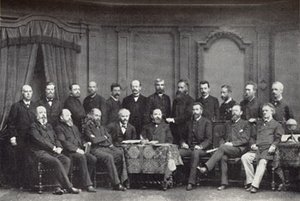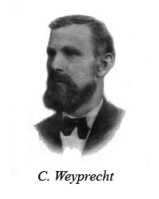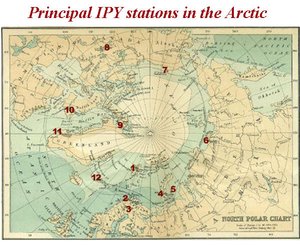First International Polar Year
Contents
Weyprecht’s inspiration
The first International Polar Year (IPY) took place from 1881 to 1884, and was the first series of coordinated international expeditions to the Polar Regions ever undertaken. The first IPY, inspired by the Austrian explorer Carl Weyprecht, was the antecedent for other international research programs such as the landmark International Geophysical Year (IGY) in 1957 and the 4th International Polar Year, which began in 2007.
By 1874 Weyprecht was aware that solutions to the fundamental problems of meteorology and geophysics were to be sought near the Earth’s poles, and that decisive results would only be obtained through a series of coordinated scientific expeditions. Weyprecht's inspiration came from his experience as a scientist and co-commander of the Austro-Hungarian Polar Expedition of 1872-74. Thousands of scientific observations were recorded, but afterwards he realized that all of the information amassed was of limited use. Weyprecht observed:
“But whatever interest all these observations may possess, they do not possess that scientific value, even supported by a long column of figures, which under other circumstances might have been the case. They only furnish us with a picture of the extreme effects of the forces of Nature in the Arctic regions, but leave us completely in the dark with respect to their causes.
Nations should put aside their unprofitable competition for mere geographical discovery, he said, and instead field a series of coordinated expeditions dedicated to scientific research. The work of these expeditions would be: “with instruments precisely alike, governed by precisely the same instructions, and for a period of one year at least, to record a series of the utmost possible synchronous observations.” Only in this way, he said, “shall we be placed in possession of materials enabling us to attempt a solution of the problems which now lie embedded in the Arctic ice…”
Weyprecht died in 1881, but his inspiration lead to the largest coordinated series of scientific expeditions ever undertaken in the Arctic during the 19th century—to what is now known as the First International Polar Year.
So extensive and dangerous a work
During the first IPY eleven nations combined to establish fourteen principal research stations spread across the Polar Regions; twelve were located in the Arctic (see map), along with at least 13 auxiliary stations. Some 700 men incurred the dangers of Arctic service to establish and relieve these stations between 1881 and 1884. Leading geophysical observatories around the world also contributed to the coordinated research program of the IPY.
Sanguine hopes
By 1884 the field program of the first IPY was finished, but the difficult work of reducing, analyzing and publishing the results was just beginning. Greely (1886) wrote, “The scientific work of these stations must be justly measured by the final result." In the end, no fundamental discoveries were made as a result of the first IPY. The heart of the research program devised by Weyprecht was the coordinated program of observation, but these data so painstakingly acquired were never fully utilized. Each nation published their observations independently and the International Polar Commission subsequently dissolved. Arktowski (1931) observed: “It may be that if the publication, and above all the discussion of the observations had been left to a central office, possibly international, the scientific level of the work accomplished would have been better appreciated.” The potential benefit of the coordinated program envisioned by Weyprecht was lost, and the first IPY was thus reduced to a series of interesting but merely concomitant expeditions.
 Members of the Fourth International Polar Conference Vienna 1884. From left to right (top): Paulson, Ekholm, Steen, Cora, Börgen, Dawson, Ray, Snellen, Wijkander, Wohlgemuth, Payen, Muller; (bottom): Lenz, Giese, Scott, Mascart, Wild, Wilczek, Mohn, Neumayer. Note: According to Heathcote and Armitage, from whose report this photo is taken, the identification of Cora, Dawson, Payen, and Giese could not be confirmed.
Members of the Fourth International Polar Conference Vienna 1884. From left to right (top): Paulson, Ekholm, Steen, Cora, Börgen, Dawson, Ray, Snellen, Wijkander, Wohlgemuth, Payen, Muller; (bottom): Lenz, Giese, Scott, Mascart, Wild, Wilczek, Mohn, Neumayer. Note: According to Heathcote and Armitage, from whose report this photo is taken, the identification of Cora, Dawson, Payen, and Giese could not be confirmed. Early records
The records of the first IPY offer a rare glimpse of the circumpolar Arctic environment as it existed in the past. These observations collected so long ago now hold the potential to improve our understanding of historical climate variability and environmental change in the Arctic.
For the first time, the synoptic meterological records of the first IPY, along with an extensive documentary image collection, have been collected in a single location in digital format.
Initial comparison of IPY data with 20th century observations of climate and environmental change in the Arctic shows that surface air temperature (SAT) and sea-level pressure (SLP) observed during 1882-83 were within limits of a recent 30-year climatology and were consistent with a positive phase of the Arctic Oscillation (AO) and North Atlantic Oscillation (NAO) pattern of variability.
Further reading
- The First International Polar Year US National Ocean and Atmospheric Administration. Accessed January 14, 2009
| Disclaimer: This article contains information that was originally published by the National Oceanic and Atmospheric Administration (NOAA). Topic editors and authors for the Encyclopedia of Earth have edited its content and added new information. The use of information from the National Oceanic and Atmospheric Administration (NOAA) should not be construed as support for or endorsement by that organization for any new information added by EoE personnel, or for any editing of the original content. |

